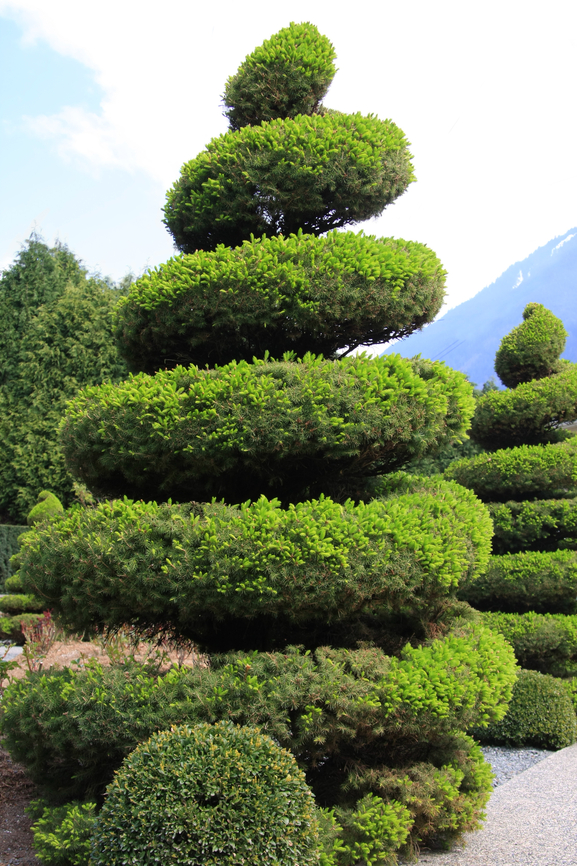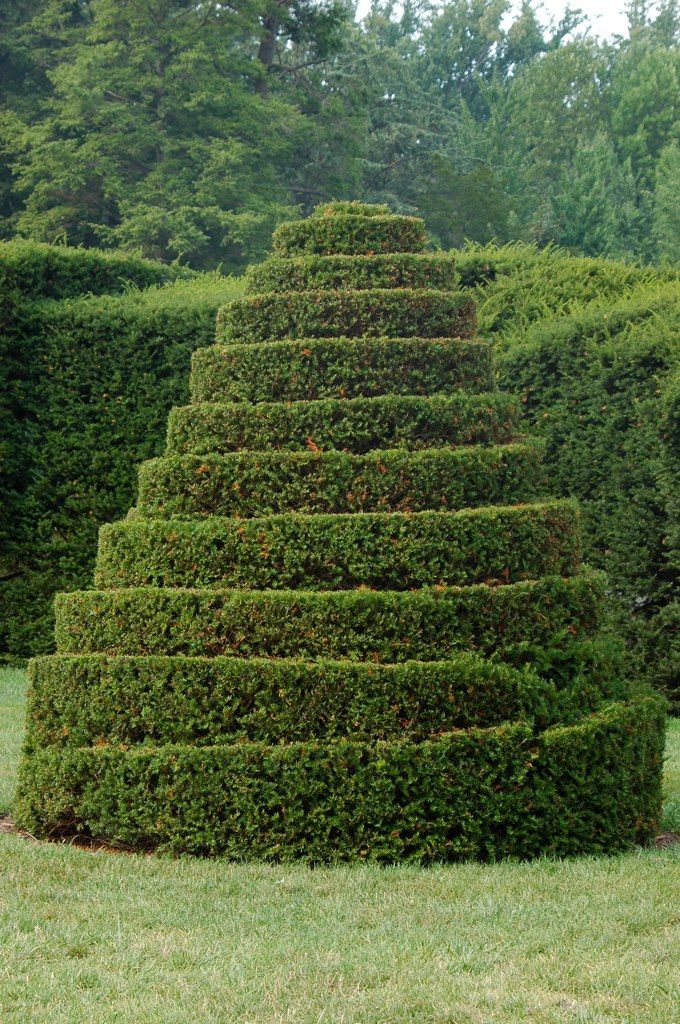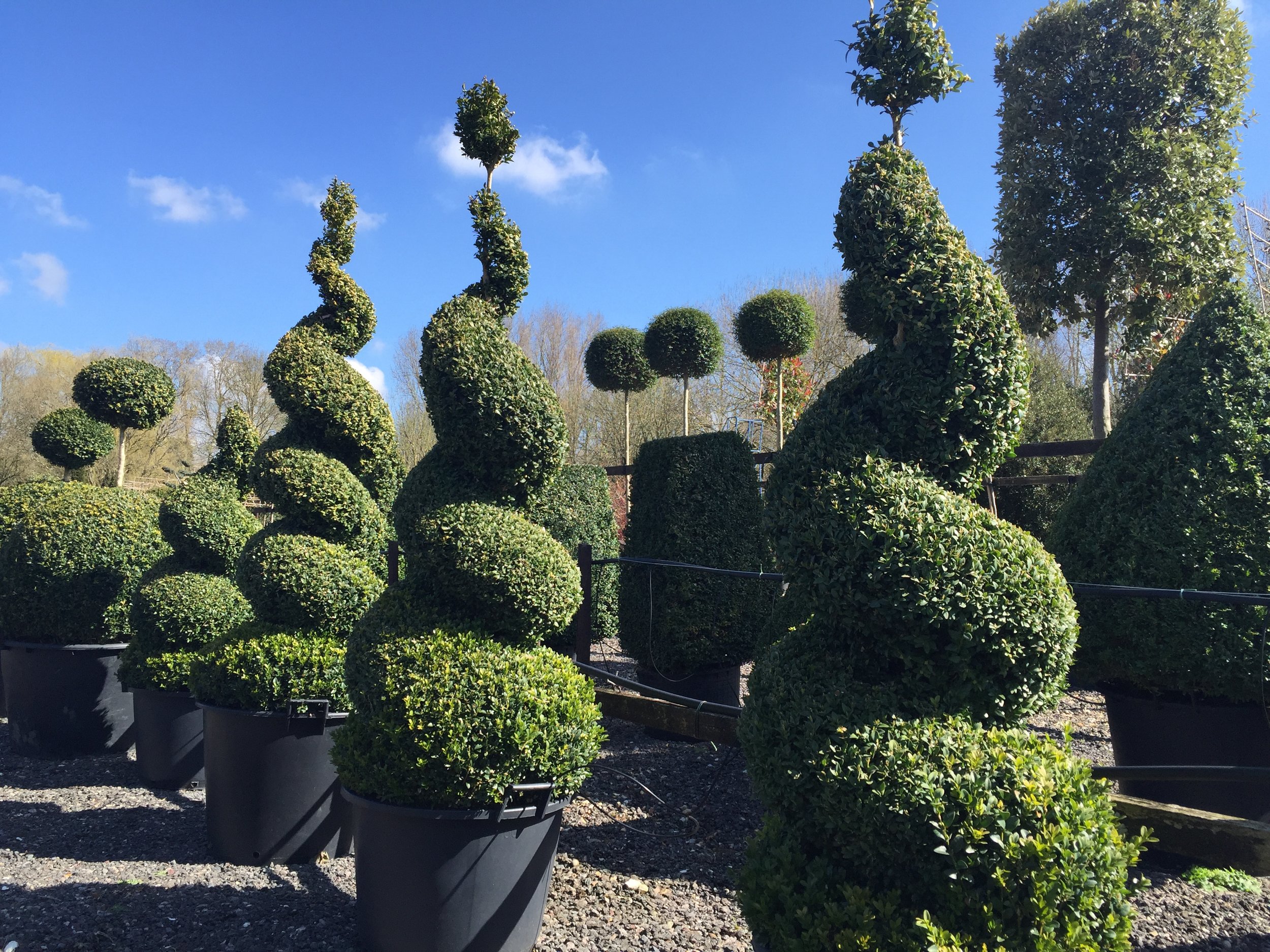The topiary style of Spiral topiary is a type of ornamental gardening practice that involves the training and shaping of trees, shrubs, and plants into a specific form, usually geometrical or animal-like shapes. The Spiral topiary style, as the name suggests, involves shaping the plant into a spiral shape.
To create a Spiral topiary, the plant is pruned and trained into a spiral shape, usually around a wire frame that helps to guide the plant’s growth in the desired direction. This process requires patience, as it can take several years to create a mature and well-formed Spiral topiary.
Spiral topiaries are typically created from plants with dense foliage, such as boxwood, yew, or privet, as these plants are easier to shape and maintain. They can be used to create striking focal points in a garden, especially when planted in pairs or groups.
To maintain a Spiral topiary, regular pruning and shaping are required, usually two or three times a year. This will help to keep the spiral shape intact and prevent the plant from becoming overgrown.
History of Spiral Topiary
The art of topiary, which involves pruning and shaping plants into ornamental shapes, has been practiced for centuries. The Spiral topiary style, in particular, has a long history that can be traced back to ancient Rome, where it was used to decorate outdoor spaces and create striking focal points.
The practice of topiary spread to other parts of Europe during the Renaissance, where it became particularly popular in formal gardens. In the 18th and 19th centuries, the Spiral topiary style gained renewed popularity, particularly in the UK, where it was used to create intricate and elaborate designs in large estate gardens. Today, Spiral topiary remains a popular gardening technique around the world, used to create stunning focal points and add a touch of elegance and artistry to any outdoor space.

How to Train Spiral Topiary
The process of training a tree or plant into a Spiral topiary shape involves careful pruning and wiring to create the desired form. Here is an overview of the steps involved in training a tree with wiring:
- Choose a plant: The first step is to choose a suitable plant for your Spiral topiary. Plants with small leaves and dense foliage are easier to shape, such as boxwood, yew, or privet.
- Create a frame: Next, create a frame that will serve as a guide for the plant’s growth. You can use a wire frame or a wooden frame, depending on your preference. The frame should be the same height as the plant and should have a spiral pattern that you want the plant to grow around.
- Prune the plant: Prune the plant to remove any unwanted growth and shape it into a cone or pyramid shape. This will create a good base for the Spiral topiary.
- Attach the wire frame: Place the wire frame over the plant, making sure that it is securely anchored in the ground. Gently guide the plant’s branches around the wire, following the spiral pattern. Use twist ties or clips to secure the branches to the wire as you go.
- Regular maintenance: To maintain the Spiral topiary’s shape, regular pruning and trimming are required. Use sharp shears to cut back any growth that is outside of the desired shape. You may need to adjust the wire frame occasionally to encourage the plant to grow in the right direction.
- Patience: The process of training a tree with wiring to create a Spiral topiary takes time and patience. It can take several years for the plant to reach the desired shape, so be patient and enjoy the process.
Overall, the process of training a tree with wiring to create a Spiral topiary is a challenging but rewarding gardening technique that can create beautiful and striking focal points in any garden.
Spiral Topiary Style Examples
there are several famous gardens that are known for their beautiful Spiral topiary designs. Here are a few examples:

- Levens Hall Gardens – Located in Cumbria, UK, Levens Hall Gardens is known for its impressive collection of topiary, including over 100 Spiral topiary shapes. The garden has been in existence for over 300 years and is one of the oldest and most famous topiary gardens in the world.
- Château de Marqueyssac – Located in the Dordogne region of France, Château de Marqueyssac features over six kilometers of walking paths lined with beautiful, sculpted boxwood hedges and dozens of Spiral topiary trees. The garden is known for its stunning views of the Dordogne River valley.
- Longwood Gardens – Located in Pennsylvania, USA, Longwood Gardens is home to over 1,000 acres of beautiful gardens, including a stunning Spiral topiary garden. The garden features dozens of meticulously pruned and shaped trees, including many Spiral topiaries.
- Boboli Gardens – Located in Florence, Italy, the Boboli Gardens are a beautiful example of Renaissance-style gardens, featuring fountains, sculptures, and extensive topiary. The garden’s Spiral topiary designs are particularly impressive, including several trees that have been shaped into spiral columns.
These gardens are just a few examples of the many beautiful Spiral topiary style gardens around the world. Whether you’re a gardening enthusiast or simply appreciate the artistry of beautiful outdoor spaces, a visit to one of these gardens is sure to be a memorable experience.
